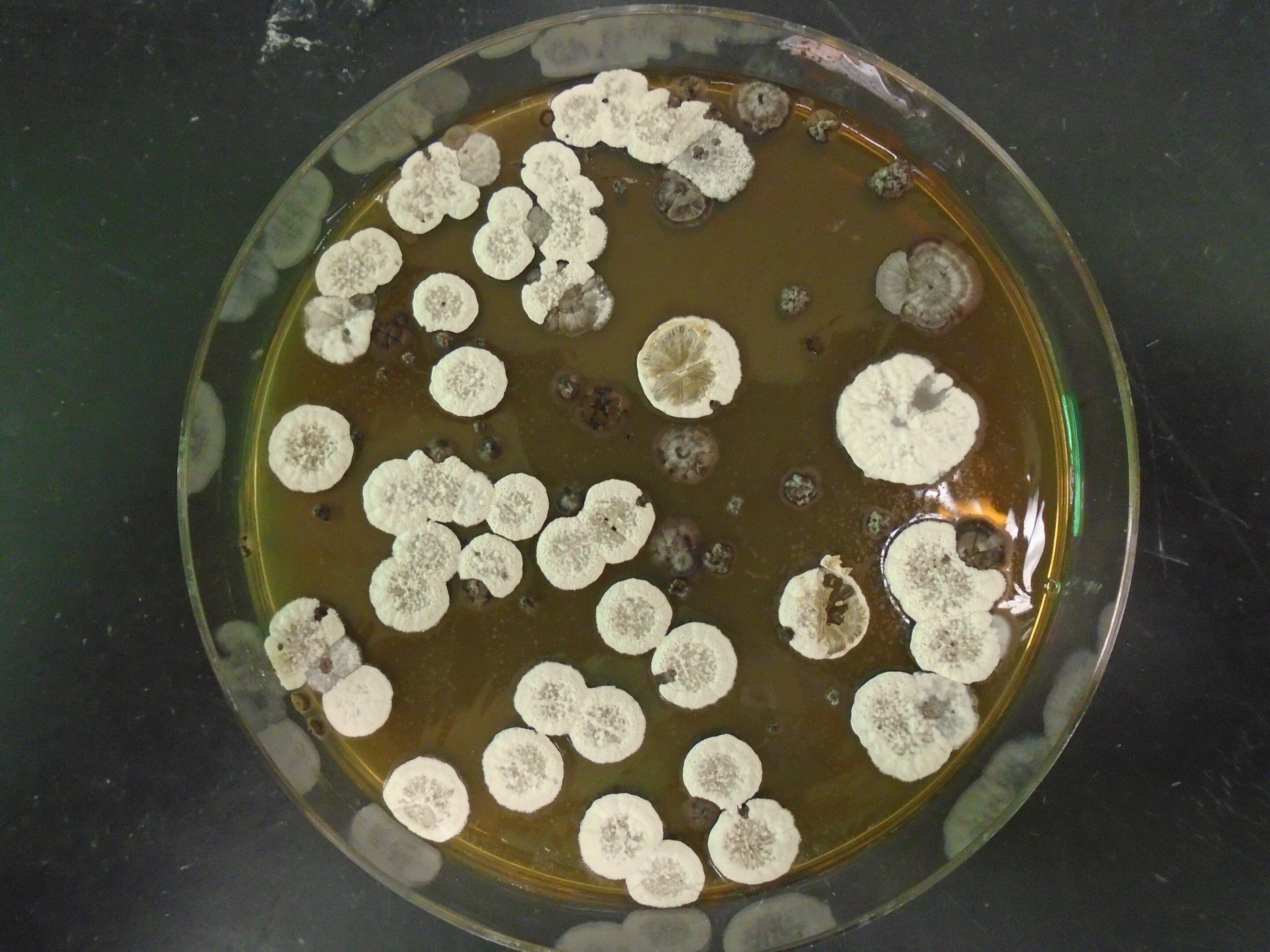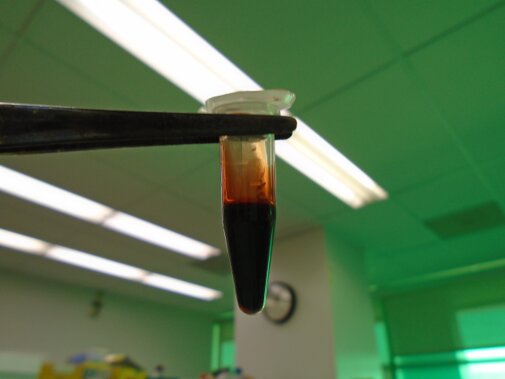博文
细菌吃东西时会产生一种不寻常的三角形分子,可被用于制造喷气燃料
||
细菌吃东西时会产生一种不寻常的三角形分子,可被用于制造喷气燃料
诸平


Fig. 2 Extract containing Jawsamycin. Credit: Pablo Morales-Cruz
https://phys.org/news/2022-06-bacteria-unusual-triangular-molecule-jet.html
据细胞出版社(Cell Press)2022年6月30日提供的消息,当某些细菌吃东西时,它们会产生一种不寻常的三角形分子,可被用于制造喷气燃料(As these bacteria eat, they generate an unusual triangular molecule that can be used to make jet fuel)。上述图示就是制造环含有丙烷分子的常见细菌链霉菌(streptomyces)。
飞机运送人员、运送货物和执行军事行动,但为其提供动力的石油燃料供应不足。美国劳伦斯伯克利实验室(Lawrence Berkeley Lab)的研究人员2022年6月30日发表在《焦耳》(Joule)杂志上的研究报告——Pablo Cruz-Morales, Kevin Yin, Alexander Landera, John R. Cort, Robert P. Young, Jennifer E. Kyle, Robert Bertrand, Anthony T. Iavarone, Suneil Acharya, Aidan Cowan, Yan Chen, Jennifer W. Gin, Corinne D. Scown, Christopher J. Petzold, Carolina Araujo-Barcelos, Eric Sundstrom, Anthe George, Yuzhong Liu, Sarah Klass, Alberto A. Nava, Jay D. Keasling. Biosynthesis of polycyclopropanated high energy biofuels(Open Access). Joule, 2022, 6: 1-16. Published: June 30, 2022. DOI: 10.1016/j.joule.2022.05.011. http://www.cell.com/joule/fulltext/S2542-4351(22)00238-0
参与此项研究的除了来自美国劳伦斯伯克利国家实验室(Lawrence Berkeley National Laboratory, USA)的研究人员之外,还有来自美国加州大学伯克利分校(University of California, Berkeley, USA)、美国桑迪亚国家实验室(Sandia National Laboratories, Livermore, USA)、美国太平洋西北国家实验室(Pacific Northwest National Laboratory, Richland, USA)、中国深圳先进技术研究院(Shenzhen Institutes for Advanced Technologies, P.R. China)以及丹麦技术大学(Technical University Denmark, Kemitorvet, Denmark)的研究人员。
在此报告中研究人员发现了一种方法,可以通过采集土壤中常见细菌代谢过程中产生的一种不寻常的碳分子来生成替代航空燃料。
“在化学中,任何需要能量才能制造出来的东西,当它破碎时都会释放出能量,”上述论文的第一作者、丹麦技术大学(Technical University of Denmark)生物支撑研究机构(DTU Biosustain)的微生物学家巴勃罗·克鲁兹-莫拉莱斯(Pablo Cruz-Morales)说。当石油喷气燃料被点燃时,它会释放出大量的能量,劳伦斯伯克利实验室杰伊·凯斯林实验室(Jay D. Keasling Lab)的科学家们认为,一定有办法复制这一点,而不必等待数百万年新化石燃料的形成。
加州大学伯克利分校(University of California,Berkeley)的化学工程师杰伊·凯斯林与当时在其实验室担任博士后的巴勃罗·克鲁兹-莫拉莱斯进行了接触,以了解他是否能够合成一种有可能产生大量能量的复杂分子。
巴勃罗·克鲁兹-莫拉莱斯说:“杰伊·凯斯林告诉我:这将是一个爆炸性的想法。”
杰伊·凯斯林想要重新创造的分子被称为Jawsamycin,以电影《大白鲨》(Jaws)的名字命名,因为它有咬痕,是由常见的细菌链霉菌(streptomyces)创造的,巴勃罗·克鲁兹-莫拉莱斯过去曾研究过这种微生物。
巴勃罗·克鲁兹-莫拉莱斯说:“配方已经存在于自然界。”这种锯齿状分子是细菌在咀嚼葡萄糖(glucose)时自然代谢产生的。他说:“当它们吃糖或氨基酸(amino acids)时,会将其分解并转化为碳—碳键(carbon-to-carbon bonds)的构建块。你以同样的方式、同样的化学成分在体内制造脂肪,但这一细菌过程有一些非常有趣的曲折。”
这些扭曲使分子具有爆炸性,是环丙烷环(cyclopropane rings)的结合,环由三个碳原子组成,呈三角形排列。巴勃罗·克鲁兹-莫拉莱斯解释说:“如果你有一个正常角度的键,一个开放的碳链,碳可以是灵活的,而且它们会很舒服。假设你把它们做成一个由六个碳组成的环,它们仍然可以移动和跳舞。但三角形的形状会使键弯曲,而这种张力需要能量来产生。”
经过仔细分析,研究小组确定负责构建这些高能环丙烷分子的酶是聚酮合成酶(polyketide synthases)。巴勃罗·克鲁兹-莫拉莱斯说:“聚酮合成酶是制造有机化学的最终生物工具。”
巴勃罗·克鲁兹-莫拉莱斯解释说,细菌产生的燃料与生物柴油非常相似。需要对其进行处理,使其能够在比燃烧脂肪酸所需的温度更低( lower temperature)的温度下点火,但一旦点火,其威力足以将火箭送入太空。巴勃罗·克鲁兹-莫拉莱斯说:“如果我们能用生物制造这种燃料,就没有理由用石油制造。这为可持续发展提供了可能性。”
在未来,巴勃罗·克鲁兹-莫拉莱斯希望他和参与该项目的能源部研究人员团队能够扩大这一过程,以便他们的替代燃料(alternative fuel )能够实际用于飞机。巴勃罗·克鲁兹-莫拉莱斯说:“现在的问题是化石燃料是有补贴的。这不仅与技术有关,而且与地球目前的地缘政治和社会政治构成(geopolitical and socio-political constitution)有关。你可以将此视为目前的准备工作,因为我们将耗尽化石燃料,在不远的将来,我们将需要替代解决方案。”
这项工作由美国能源部联合生物能源研究所(DOE Joint BioEnergy Institute)资助,美国能源部(U.S. Department of Energy)、科学办公室(Office of Science)、生物与环境研究办公室(Office of Biological and Environmental Research)和燃料与发动机协同优化(Co-Optimization of Fuels & Engines简称Co-Optima)项目由美国能源部(DOE)能源效率和可再生能源办公室(Energy Efficiency and Renewable Energy简称EERE)、生物能源技术(Bioenergy Technologies)和车辆技术办公室(Vehicle Technologies Offices)赞助,根据能源部和劳伦斯伯克利国家实验室签订的DEAC02-05CH11231合同。也获美国国家科学基金研究生研究基金资助(National Science Foundation Graduate Research Fellowship, fellow ID 2018253421)和墨西哥SENER-CONACYT可持续能源基金资助(SENER-CONACYT Sustainable Energy Fund, Mexico with grant 282203)。
上述介绍,仅供参考。欲了解更多信息,敬请注意浏览原文或者相关报道。
• Rocketry, aviation, and shipping require hard-to-replace, energy-dense fossil fuels
• Cylopropanated fuels are energy dense, but their synthesis is challenging
• We produced polycyclopropanated (POP) fuels using a bacterial host
• The POP biofuels can have higher energy density than current aerospace fuels
Freeing the global economy from its dependance on petroleum is key to slow down the pace of climate change. Energy-demanding applications like rocketry, aviation, and shipping are fueled with petroleum-derived hydrocarbons that are difficult to replace. These fuels are rich in cyclic molecules with strained bond angles allowing them to store more energy than non-cyclic molecules. The highest amount of energy can be stored in cyclopropanes, but these molecules are hard to produce via organic synthesis.
We produced polycyclopropanated fatty acid methyl ester (POP-FAME) fuels in bacteria. The POP-FAMEs can have energy densities of more than 50 MJ/L, which is larger than the energy of the most widely used rocket and aviation fuels. Although the next step is to scale up their production until the process is commercially viable, the availability of a biobased production method opens the possibility to replace fossil fuels in a very constrained sector.
Cyclopropane-functionalized hydrocarbons are excellent fuels due their high energy density. However, the organic synthesis of these molecules is challenging. In this work, we produced polycyclopropanated fatty acids in bacteria. These molecules can be converted into renewable fuels for energy-demanding applications such as shipping, long-haul transport, aviation, and rocketry. We explored the chemical diversity encoded in thousands of bacterial genomes to identify and repurpose naturally occurring cyclopropanated molecules. We identified a set of candidate iterative polyketide synthases (iPKSs) predicted to produce polycyclopropanated fatty acids (POP-FAs), expressed them in Streptomyces coelicolor, and produced POP-FAs. We determined the structure of the molecules and increased their production 22-fold. Finally, we produced polycyclopropanated fatty acid methyl esters (POP-FAMEs). Our POP fuel candidates can have net heating values of more than 50 MJ/L. Our research shows that the POP-FAMEs and other POPs have the energetic properties for energy-demanding applications for which sustainable alternatives are scarce.
https://blog.sciencenet.cn/blog-212210-1346118.html
上一篇:在光的环境条件下将甲烷转化为甲醇的“催化圣杯”
下一篇:研究人员发现了一种取决于入射光波长的电压
